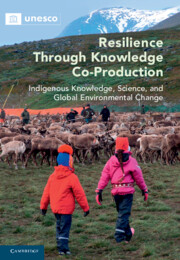 Resilience through Knowledge Co-Production
Resilience through Knowledge Co-Production Book contents
- Resilience through Knowledge Co-production
- Resilience through Knowledge Co-production
- Copyright page
- Contents
- Contributors
- Acknowledgements
- Introduction
- Part I From Practice to Principles
- 2 The Progression from Collaboration to Co-production: Case Studies from Alaska
- 3 Learning about Sea Ice from the Kifikmiut: A Decade of Ice Seasons at Wales, Alaska, 2006-2016
- 4 Shaping the Long View: Iñupiat Experts and Scientists Share Ocean Knowledge on Alaska’s North Slope
- 5 Indigenous Ice Dictionaries: Sharing Knowledge for a Changing World
- 6 Mapping Land Use with Sámi Reindeer Herders: Co-production in an Era of Climate Change
- 7 Sámi Herders’ Knowledge and Forestry: Ecological Restoration of Reindeer Lichen Pastures in Northern Sweden
- Part II Indigenous Perspectives on Environmental Change
- Part III Global Change and Indigenous Responses
- Epilogue
- Index
- References
3 - Learning about Sea Ice from the Kifikmiut: A Decade of Ice Seasons at Wales, Alaska, 2006-2016
from Part I - From Practice to Principles
Published online by Cambridge University Press: 02 June 2022
- Resilience through Knowledge Co-production
- Resilience through Knowledge Co-production
- Copyright page
- Contents
- Contributors
- Acknowledgements
- Introduction
- Part I From Practice to Principles
- 2 The Progression from Collaboration to Co-production: Case Studies from Alaska
- 3 Learning about Sea Ice from the Kifikmiut: A Decade of Ice Seasons at Wales, Alaska, 2006-2016
- 4 Shaping the Long View: Iñupiat Experts and Scientists Share Ocean Knowledge on Alaska’s North Slope
- 5 Indigenous Ice Dictionaries: Sharing Knowledge for a Changing World
- 6 Mapping Land Use with Sámi Reindeer Herders: Co-production in an Era of Climate Change
- 7 Sámi Herders’ Knowledge and Forestry: Ecological Restoration of Reindeer Lichen Pastures in Northern Sweden
- Part II Indigenous Perspectives on Environmental Change
- Part III Global Change and Indigenous Responses
- Epilogue
- Index
- References
Summary
In recent years, reductions in Arctic sea ice extent and thickness have been most pronounced in the Pacific Arctic sector. In addition to major losses of summer ice in the Chukchi Sea, the Bering Sea ice cover transitioned from above-normal winter ice extent to near complete absence of sea ice in winter in a few years. We highlight observations and findings by Kifikmiut sea-ice experts from the community of Wales in the Bering Strait, Alaska. These observations and the Indigenous knowledge in which they are embedded provide insights into sea-ice change from the perspective of ice users intimately familiar with the cultural landscape of sea ice and its important role in the coastal environment. Our collaborator, the late Winton Weyapuk, Jr., in particular, was instrumental in helping establish a coastal community Indigenous observer network in 2006 during the International Polar Year that radiated out from Wales and continues to grow and thrive. We compare the seasonal sea-ice cycle based on Mr. Weyapuk’s observations for the ice seasons of 2006/07 and 2015/16, illustrating the importance of sea ice for coastal Alaska communities and discussing key aspects of ice-cover demise and its impacts.
Keywords
- Type
- Chapter
- Information
- Resilience through Knowledge Co-ProductionIndigenous Knowledge, Science, and Global Environmental Change, pp. 43 - 66Publisher: Cambridge University PressPrint publication year: 2022


